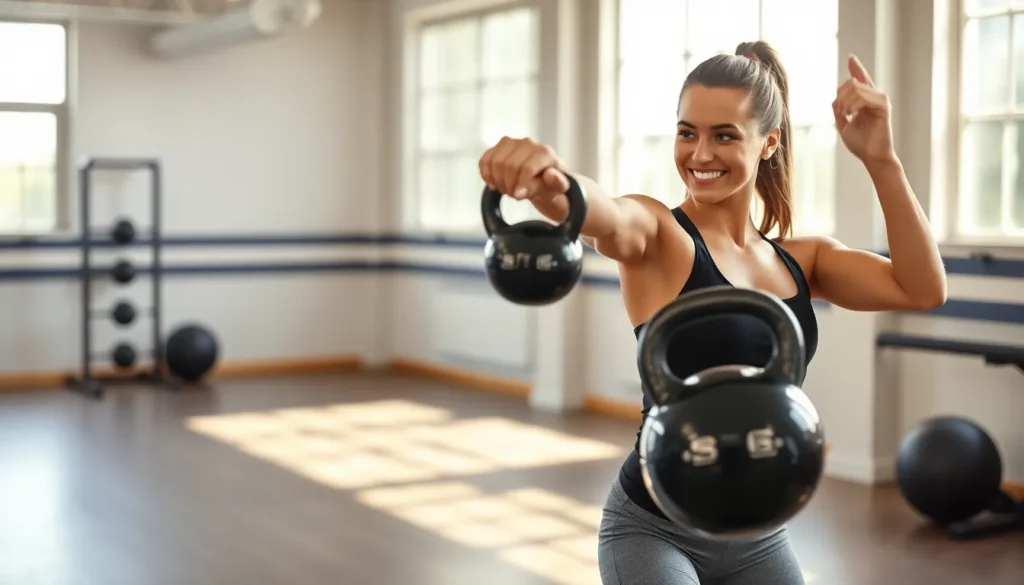Kettlebell workouts have taken the fitness world by storm, and for good reason. Imagine swinging a cannonball with a handle—that’s basically what a kettlebell is, and it packs a punch like no other piece of equipment. Whether you’re looking to build strength, increase endurance, or just impress your friends with your newfound ability to lift heavy things, kettlebells have got your back.
But it’s not all sweat and grunting. Kettlebell workouts can be fun, dynamic, and surprisingly versatile. They’ll have you swinging, squatting, and flipping your way to a fitter you, all while keeping boredom at bay. So grab a kettlebell, channel your inner warrior, and get ready to turn your living room into a personal gym. Who knew fitness could feel this good—or look this cool?
Table of Contents
ToggleBenefits Of Kettlebell Workouts
Kettlebell workouts provide numerous advantages that contribute to overall fitness improvement. They engage multiple muscle groups while offering variety in exercise routines.
Full-Body Conditioning
Kettlebell training targets various muscle groups simultaneously. Engaging core, legs, arms, and back throughout the workout enhances functional strength. Individuals notice improved balance and coordination as they perform dynamic movements. These workouts promote cardiovascular fitness, as they elevate heart rates effectively. Consistent kettlebell training fosters greater flexibility, allowing easier movement in daily activities. Adopting kettlebell workouts maximizes caloric burn compared to traditional strength training alone. Embracing kettlebells leads to a more comprehensive fitness approach.
Enhanced Strength and Endurance
Kettlebell workouts significantly boost strength levels across the body. Heavy swinging and lifting of kettlebells create greater muscle activation. This activation promotes rapid improvements in muscular endurance over time. Performance increases as muscles adapt to sustain exertion. Users often report enhanced core stability, reducing the risk of injury during other workouts. Regular kettlebell training also facilitates better posture, benefiting overall body mechanics. Training with different weights allows gradual progress, accommodating various fitness levels. Over time, kettlebell exercises lead to sustainable strength development.
Types Of Kettlebell Exercises

Kettlebell exercises encompass a variety of movements that target different muscle groups. Some of the most effective include swings, goblet squats, and the Turkish get-up.
Swings
Swings engage the posterior chain, primarily affecting the glutes and hamstrings. Performing swings involves a hip hinge motion, which enhances power and strength. Individuals can execute this movement with one or both hands gripping the kettlebell. Consistency in this exercise boosts cardiovascular endurance and increases calorie burn. Studies emphasize how kettlebell swings significantly improve overall athletic performance due to their explosive nature.
Goblet Squats
Goblet squats strengthen the legs and core while promoting proper squat mechanics. By holding the kettlebell close to the chest, individuals maintain an upright posture during the descent. This exercise encourages balance and coordination, essential for functional fitness. Many trainers recommend goblet squats for beginners as it serves as a foundation for more complex movements. The versatility ensures individuals can adjust weight for a customized workout experience.
Turkish Get-Up
Turkish get-ups provide a full-body workout that enhances mobility and core stability. This intricate movement requires transitioning from lying down to standing while holding the kettlebell overhead. Focus on each phase fosters strength in various muscle groups, including the shoulders and core. Practicing this exercise systematically improves functional strength, which translates to daily activities. Utilizing lighter weights initially aids in mastering the technique before progressing to heavier kettlebells.
How To Incorporate Kettlebell Workouts Into Your Routine
Kettlebell workouts fit seamlessly into various training schedules. Integrating them boosts overall fitness while providing variety.
Beginner Guidelines
Start by choosing a kettlebell weight that matches current fitness levels. Using a lighter kettlebell aids in mastering form and technique. Common beginner exercises include swings, goblet squats, and deadlifts. Each movement prioritizes proper alignment to prevent injury. Perform 2 to 3 sets of 8 to 12 repetitions, allowing for rest between sets. Gradually increase weight or repetitions as strength improves. Maintain consistency by scheduling workouts 2 to 3 times a week. This approach enhances familiarity with the equipment while building confidence.
Advanced Techniques
Advanced kettlebell workouts introduce complex movements and heavier weights. Incorporating exercises like single-arm swings and Turkish get-ups challenges strength and stability. Aiming for 3 to 5 sets of 6 to 10 repetitions enhances muscular endurance. Use explosive movements for swings to maximize power generation. Combining kettlebell training with high-intensity interval training (HIIT) can boost cardiovascular fitness. Adjust training frequency to 3 to 5 times a week for optimal results. Focus on targeted muscle groups during each session to avoid overtraining. Utilizing these techniques promotes greater performance gains and adaptability in fitness levels.
Safety Tips For Kettlebell Workouts
Prioritizing safety during kettlebell workouts ensures effective training and minimizes injury risk. Proper techniques and awareness make a significant difference.
Proper Form
Exhibiting correct form is essential to harnessing kettlebell benefits. Maintaining a straight back during swings prevents strain on the lower back. Grip the kettlebell tightly, as a secure hold enhances control and stability. Feet should align with shoulder width while keeping knees slightly bent. Breathing properly supports movements; inhaling during the downward movement and exhaling when lifting aids performance. Performing each exercise slowly enables awareness of posture and mechanics. Practicing in front of a mirror helps visualize form and adjust as needed. Beginners should start with lighter weights to master postural alignment before transitioning to heavier kettlebells.
Avoiding Common Injuries
Identifying potential injuries aids in maintaining workout safety. Engaging in a proper warm-up enhances joint mobility and prepares muscles for exertion. Keeping movements within a comfortable range of motion prevents overextension. Listen to the body; pain or discomfort signals the need for a break or adjustment. When transitioning between exercises, avoid sudden, jerky movements that may lead to strain. Rotator cuff injuries can occur from improper overhead lifts, so focus on shoulder stability during exercises. Cross-training with other forms of exercise diversifies muscle engagement, decreasing the risk of overuse injuries. Regularly reassessing form and technique alongside checking equipment condition further promotes a secure training environment.
Kettlebell workouts offer a versatile and engaging way to enhance fitness routines. With their ability to target multiple muscle groups they provide an effective full-body workout that improves strength endurance and flexibility. The dynamic nature of kettlebell training keeps workouts fresh and enjoyable encouraging individuals to stay committed to their fitness goals.
Whether someone is a beginner or an advanced practitioner kettlebells can be adapted to fit various fitness levels. By focusing on proper form and gradually increasing intensity individuals can safely reap the benefits of this powerful training method. Embracing kettlebell workouts not only leads to improved physical performance but also fosters a sense of accomplishment and enjoyment in the journey toward better health.





